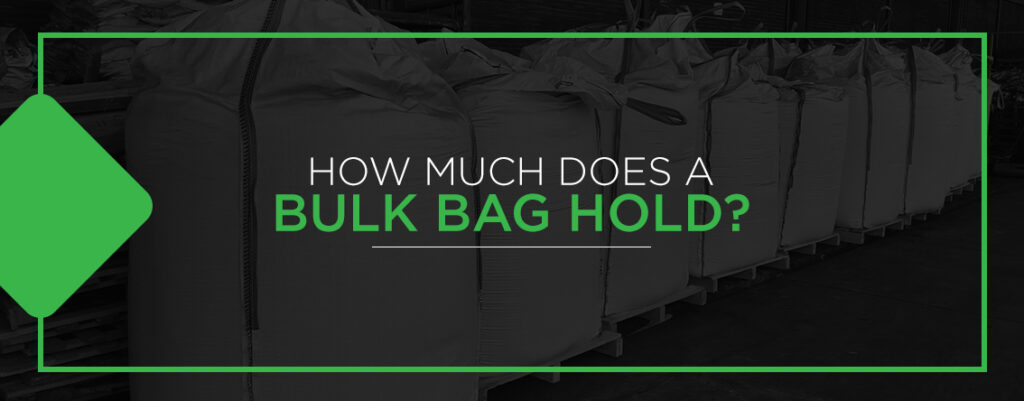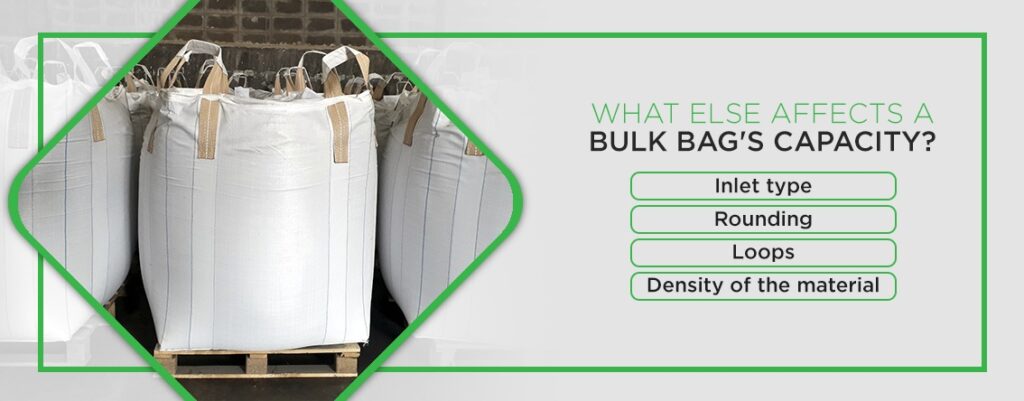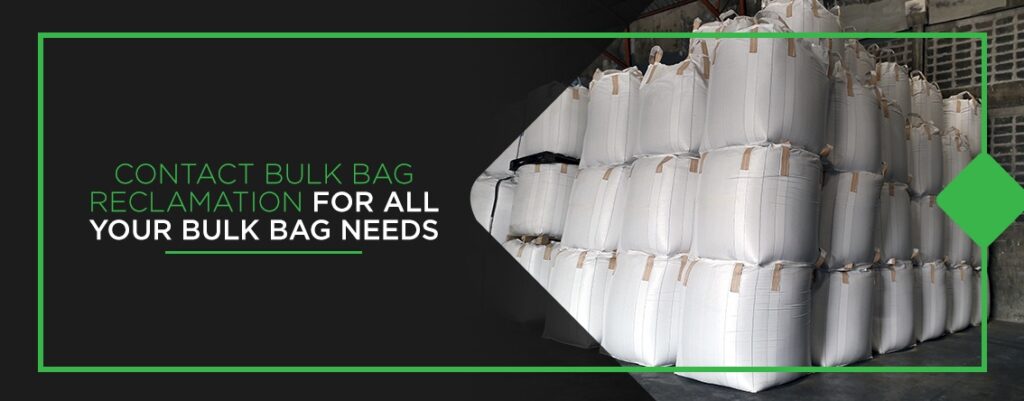How Much Does a Bulk Bag Hold?
Bulk bags, also known as flexible intermediate bulk containers (FIBCs), offer many rewarding benefits for businesses. They are dependable, lightweight, portable and stowable, and they offer the lowest package-to-product weight of any intermediate industrial container. They are suitable for use across a wide range of industries, including:
- Agriculture
- Food processing
- Construction
- Mining
- Pharmaceuticals manufacturing
Plus, using reconditioned bulk bags helps reduce waste and preserve the environment. But, how much does a bulk bag hold? In the guide below, we’ll discuss bulk bag capacity, what factors go into determining that capacity and how to take volume and weight limits into account in transport.
How to Calculate a Bulk Bag’s Capacity
A bulk bag’s capacity indicates how much material it can hold. Whether you’re using your bulk bags to transport sand, gravel, animal feed or another substance, the capacity tells you what volume of material can fit into the bag. Bulk bag capacity is often given in cubic meters — for example, one cubic meter for a standard-sized bag — though different companies may use cubic feet. It’s easy to convert between the two using a conversion table or an online calculator.
So, how much volume does a bulk bag hold? Volumetric capacity depends on the bag. The dimensions of a bulk bag are helpful determiners. In general, bulk bags follow the basic formula for volume: volume equals length times width times height. Under this formula, a 35-inch by 35-inch by 35-inch bag can hold about 42,875 cubic inches, or 25 cubic feet, of material. Bags with larger dimensions offer increased capacity.
However, bulk bag manufacturers also typically take the effects of bulging into their capacity calculations. Bulging occurs when the sides of a bulk bag bow outward under the pressure of the product filling them. Bulging is natural, safe and expected — the material of the bag is sturdy and flexible.
Because bulging allows the bag to expand beyond its initial dimensions, it also allows for a slightly greater capacity than you would expect from the formula given above. So, manufacturers often add a little extra to the capacity as determined by the product of the length, width and height of the bag.
Choosing Bulk Bags for Capacity
If you’re customizing bulk bags, you may want to adjust their dimensions to add capacity. Or, if you’re purchasing standard-issue or reconditioned recycled bulk bags, you may want to consider how extra capacity may affect other factors, like storage and transport convenience.
Often, the best dimension to expand to add more capacity to a bulk bag is height. Though some FIBCs have larger footprints, many come in the standard base size of 35 by 35 inches — these dimensions allow them to fit onto standard pallets. If you increase your bags’ capacity by adding a little length or width, they will probably still fit on common carriers, but they’ll become too big for most pallets. But, adding height helps increase bag capacity while still keeping your bags convenient for pallet storage and transport.
It’s important to distinguish volumetric capacity — the volume of material that can fit into a bag — from the weight limit, which is the amount of weight the bag can safely hold. Different FIBCs have different maximum load weights and safe dimension limits. To figure out the safe capacity for your bags, consult with a professional bulk bag company like Bulk Bag Reclamation.
What Else Affects a Bulk Bag’s Capacity?
How much does a bulk bag hold when it has different features or is designed for a specific use, and how can you tell what will affect its capacity? Here are a few factors that play a role:
- Inlet type: The filling inlet of a bulk bag plays a role in the bag’s capacity. If your bag has an open top, you may have increased flexibility in terms of your bag’s capacity, especially with larger bulk items like lumber that could stick out from the opening at the top. If your bag has a spout top that takes up space, the capacity may be more restricted.
- Rounding: Bulk bags are usually designed as cubes, with a base and four sides. But because the material of the bags is flexible, the bags tend to become round as they fill. This rounding can squeeze the product and diminish capacity. Baffled bulk bags help solve this problem — they contain sewn-in, reinforced panels to resist rounding and preserve capacity.
- Loops: The lifting loops of a bulk bag also play a role in the bag’s capacity because they help determine how large the bag can feasibly be. When you use lifting loops, your bag needs additional clearance equal to the height of the bag plus the height of the loops — not just the height of the bag. You may end up using smaller FIBCs with more modest capacities in this case.
- Density of the material: Bulk bags carry different types of materials, some with lower densities and some with higher ones. The higher the density of the material, the lower the capacity of the bag becomes.
Low-Density Materials vs. High-Density Materials
We’ve discussed volumetric capacity, but what about weight? How much weight in a bulk bag is too much? And how does that weight affect capacity?
The type of materials you plan to transport in your bulk bags will impact on the bags’ capacities. Whether your bags will hold low-density materials or high-density materials will make a difference in how much product you can load them with.
High-density materials are much heavier than low-density materials of the same volume. A cubic foot of a high-density material like steel weighs much more than a cubic foot of a low-density material like polystyrene. So, although you may be able to fill a bulk bag to the brim with a low-density material, the same amount of a high-density material might cause the bag to exceed its weight limit, which is commonly known as the safe working load (SWL) of the bag.
If you plan to ship low-density materials, you’ll be able to load FIBCs to their full volumetric capacity without exceeding the SWL. If you plan to ship high-density materials, you may need to under load the bags to avoid exceeding the SWL and creating a safety hazard for employees and consumers.
Contact Bulk Bag Reclamation for All Your Bulk Bag Needs
To experience the advantages of reconditioned recycled bulk bags for your business, contact Bulk Bag Reclamation. We have a variety of stock inventory with different styles to choose from, including duffle top bags, spout top bags, open-top bags and baffled bags. You’ll gain reliable, lightweight, stowable containers that allow you to do your part to protect the environment by reusing materials.
Contact us today to learn more, or request a quote online.



